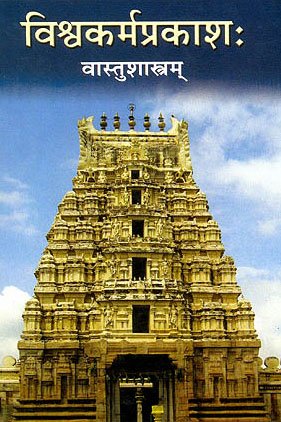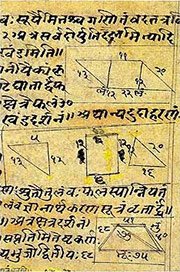Abja, Abjā: 24 definitions
Introduction:
Abja means something in Hinduism, Sanskrit, the history of ancient India, Marathi, biology. If you want to know the exact meaning, history, etymology or English translation of this term then check out the descriptions on this page. Add your comment or reference to a book if you want to contribute to this summary article.
In Hinduism
Shilpashastra (iconography)
Source: Wisdom Library: Śilpa-śāstraAbja (अब्ज, “lotus”):—In Hindu iconology (śilpaśāstra), this symbol represents enlightenment and purity. It is also one of six items that Agni is displayed carrying. Agni, one of the most important Vedic gods, represents divine illumination

Shilpashastra (शिल्पशास्त्र, śilpaśāstra) represents the ancient Indian science (shastra) of creative arts (shilpa) such as sculpture, iconography and painting. Closely related to Vastushastra (architecture), they often share the same literature.
Purana and Itihasa (epic history)
Source: Cologne Digital Sanskrit Dictionaries: The Purana Index1a) Abja (अब्ज).—An attribute of Brahmā.*
- * Brahmāṇḍa-purāṇa IV. 5. 31.
1b) (abjam, abdam)—100 crores.*
- * Brahmāṇḍa-purāṇa IV. 2. 94; Vāyu-purāṇa 101. 95.

The Purana (पुराण, purāṇas) refers to Sanskrit literature preserving ancient India’s vast cultural history, including historical legends, religious ceremonies, various arts and sciences. The eighteen mahapuranas total over 400,000 shlokas (metrical couplets) and date to at least several centuries BCE.
Ayurveda (science of life)
Kalpa (Formulas, Drug prescriptions and other Medicinal preparations)
Source: Shodhganga: Edition translation and critical study of yogasarasamgrahaAbja (अब्ज) is another name for “Padma” and is dealt with in the 15th-century Yogasārasaṅgraha (Yogasara-saṅgraha) by Vāsudeva: an unpublished Keralite work representing an Ayurvedic compendium of medicinal recipes. The Yogasārasaṃgraha [mentioning abja] deals with entire recipes in the route of administration, and thus deals with the knowledge of pharmacy (bhaiṣajya-kalpanā) which is a branch of pharmacology (dravyaguṇa).
Toxicology (Study and Treatment of poison)
Source: Shodhganga: Kasyapa Samhita—Text on Visha ChikitsaAbja (अब्ज) (or Padma) refers to “snakes with the body marked by lotus; moves tail” and represents a classification of Divine Snakes, as taught in the Nāganāman (“names of the Sarpas”) section of the Kāśyapa Saṃhitā: an ancient Sanskrit text from the Pāñcarātra tradition dealing with both Tantra and Viṣacikitsā—an important topic from Āyurveda which deals with the study of Toxicology (Agadatantra or Sarpavidyā).—The first aspect of the Agadatantra is about the names of the sarpas and their features. The Kāśyapasaṃhitā verse IV.6-19 provide information on divine serpents [e.g., Abja], their characterstic features, origin and other details.

Āyurveda (आयुर्वेद, ayurveda) is a branch of Indian science dealing with medicine, herbalism, taxology, anatomy, surgery, alchemy and related topics. Traditional practice of Āyurveda in ancient India dates back to at least the first millenium BC. Literature is commonly written in Sanskrit using various poetic metres.
Vastushastra (architecture)
Source: OpenEdition books: Architectural terms contained in Ajitāgama and RauravāgamaAbja (अब्ज) refers to “doucine (molding) § 3.9.”.—(For paragraphs cf. Les enseignements architecturaux de l'Ajitāgama et du Rauravāgama by Bruno Dagens)

Vastushastra (वास्तुशास्त्र, vāstuśāstra) refers to the ancient Indian science (shastra) of architecture (vastu), dealing with topics such architecture, sculpture, town-building, fort building and various other constructions. Vastu also deals with the philosophy of the architectural relation with the cosmic universe.
Shaktism (Shakta philosophy)
Source: Google Books: ManthanabhairavatantramAbja (रेखा) refers to an “auspicious lotus”, according to the Manthānabhairavatantra, a vast sprawling work that belongs to a corpus of Tantric texts concerned with the worship of the goddess Kubjikā.—Accordingly, while describing the signs of one who is a Siddha: “There is (an auspicious) line on his foot and (the lines) on his hand (are shaped) like an auspicious lotus [i.e., abja]. His shoulders are equal as are (his) teeth; his neck and breasts are upraised. Or else he may be bent over. Such a one is part of the Siddha lineage. (His) thigh is (strong as if) issuing from a wheel and he has a faint auspicious line of hair (on his belly). His gait is playful and his body well proportioned. Such is the mark of a Siddha”.

Shakta (शाक्त, śākta) or Shaktism (śāktism) represents a tradition of Hinduism where the Goddess (Devi) is revered and worshipped. Shakta literature includes a range of scriptures, including various Agamas and Tantras, although its roots may be traced back to the Vedas.
Jyotisha (astronomy and astrology)
Source: Wisdom Library: Brihat Samhita by VarahamihiraAbja (अब्ज) refers to “pearls”, according to the Bṛhatsaṃhitā (chapter 15) (“On the nakṣatras—‘asterisms’”), an encyclopedic Sanskrit work written by Varāhamihira mainly focusing on the science of ancient Indian astronomy astronomy (Jyotiṣa).—Accordingly, “[...] Those who are born on the lunar day of Mṛgaśirṣa will delight or deal in perfumes, dress, pearls (abja), flowers, fruits, precious stones, wild beasts, birds and deer; will be Somayajis or singers; will be lascivious; will be good writers or painters. Those who are born on the lunar day of Ārdrā will delight in killing, torturing, lying, in adultery, thieving, cheating and tale-bearing; will deal in pod-grains, black magic, sorcery and exorcism. [...]”.

Jyotisha (ज्योतिष, jyotiṣa or jyotish) refers to ‘astronomy’ or “Vedic astrology” and represents the fifth of the six Vedangas (additional sciences to be studied along with the Vedas). Jyotisha concerns itself with the study and prediction of the movements of celestial bodies, in order to calculate the auspicious time for rituals and ceremonies.
Ganitashastra (Mathematics and Algebra)
Source: archive.org: Hindu Mathematics1) Abja (अब्ज) represents the number 1 (one) in the “word-numeral system” (bhūtasaṃkhyā), which was used in Sanskrit texts dealing with astronomy, mathematics, metrics, as well as in the dates of inscriptions and manuscripts in ancient Indian literature.—A system of expressing numbers by means of words arranged as in the place-value notation was developed and perfected in India in the early centuries of the Christian era. In this system the numerals [e.g., 1—abja] are expressed by names of things, beings or concepts, which, naturally or in accordance with the teaching of the Śāstras, connote numbers.
2) Abja (अब्ज) refers to a “billion” (1,000,000,000) in various lists of numeral denominations, according to gaṇita (“science of calculation”) and Gaṇita-śāstra, ancient Indian mathematics and astronomy.—We can definitely say that from the very earliest known times, ten has formed the basis of numeration in India. While the Greeks had no terminology for denominations above the myriad (104), and the Romans above the milk (103), the ancient Hindus dealt freely with no less than eighteen denominations [e.g., abja]. Cf. Yajurveda-saṃhitā (Vājasanyī) XVII.2; Taittirīya-saṃhitā IV.40.11, VII.2.20.1; Maitrāyaṇī-saṃhitā II.8.14; Kāṭhaka-saṃhitā XVII.10, XXXIX.6; Anuyogadvāra-sūtra 142; Āryabhaṭīya II.2; Triśatikā R.2-3; Gaṇitasārasaṃgraha I.63-68.
Note: According to Nārāyaṇa (1356), Abja is known as Saroja.

Ganitashastra (शिल्पशास्त्र, gaṇitaśāstra) refers to the ancient Indian science of mathematics, algebra, number theory, arithmetic, etc. Closely allied with astronomy, both were commonly taught and studied in universities, even since the 1st millennium BCE. Ganita-shastra also includes ritualistic math-books such as the Shulba-sutras.
Shaivism (Shaiva philosophy)
Source: SOAS University of London: Protective Rites in the Netra TantraAbja (अब्ज) refers to a “lotus”, according to the Svacchanda-tantra.—Accordingly, [verse 7.220cd-222]—“[The Yogin] should visualize a second lotus (dvitīya-abja) above him in the great ocean with the power of amṛta as well as a lotus with its full moon mouth pointed downward. In the middle of that, he should visualize haṃsa joined with the bindu and topknot. He should visualize a divine rain of amṛta, falling everywhere and imagine [it to] enter [his body] in the opening above himself [i.e., the path through the center of the body through which the Ātman rises to śakti-tattva]”.

Shaiva (शैव, śaiva) or Shaivism (śaivism) represents a tradition of Hinduism worshiping Shiva as the supreme being. Closely related to Shaktism, Shaiva literature includes a range of scriptures, including Tantras, while the root of this tradition may be traced back to the ancient Vedas.
India history and geography
Source: Cologne Digital Sanskrit Dictionaries: Indian Epigraphical GlossaryAbja.—(IE 7-1-2), ‘one’. Note: abja is defined in the “Indian epigraphical glossary” as it can be found on ancient inscriptions commonly written in Sanskrit, Prakrit or Dravidian languages.

The history of India traces the identification of countries, villages, towns and other regions of India, as well as mythology, zoology, royal dynasties, rulers, tribes, local festivities and traditions and regional languages. Ancient India enjoyed religious freedom and encourages the path of Dharma, a concept common to Buddhism, Hinduism, and Jainism.
Biology (plants and animals)
Source: Google Books: CRC World Dictionary (Regional names)Abja in India is the name of a plant defined with Baccaurea courtallensis in various botanical sources. This page contains potential references in Ayurveda, modern medicine, and other folk traditions or local practices It has the synonym Pierardia macrostachya Wight & Arn. (among others).
Example references for further research on medicinal uses or toxicity (see latin names for full list):
· Prodromus Systematis Naturalis Regni Vegetabilis (DC.) (1866)
· Icon. Pl. Ind. Orient. (1912)
· Flora of the British India (1887)
If you are looking for specific details regarding Abja, for example extract dosage, chemical composition, pregnancy safety, side effects, diet and recipes, health benefits, have a look at these references.

This sections includes definitions from the five kingdoms of living things: Animals, Plants, Fungi, Protists and Monera. It will include both the official binomial nomenclature (scientific names usually in Latin) as well as regional spellings and variants.
Languages of India and abroad
Marathi-English dictionary
Source: DDSA: The Molesworth Marathi and English Dictionaryabja (अब्ज).—n S A thousand millions. 2 A lotus.
Source: DDSA: The Aryabhusan school dictionary, Marathi-Englishabja (अब्ज).—n A lotus. Thousand millions.
Marathi is an Indo-European language having over 70 million native speakers people in (predominantly) Maharashtra India. Marathi, like many other Indo-Aryan languages, evolved from early forms of Prakrit, which itself is a subset of Sanskrit, one of the most ancient languages of the world.
Sanskrit dictionary
Source: DDSA: The practical Sanskrit-English dictionaryAbja (अब्ज).—a. [apsu jāyate, jan-ḍa] Born in or produced from water Manusmṛti 5.112. अब्जेषु चैव रत्नेषु (abjeṣu caiva ratneṣu) 8.1
-bjaḥ 1 The conch; गाण्डीवं व्याक्षिपत्पार्थः कृष्णोऽप्यब्जमवादयत् (gāṇḍīvaṃ vyākṣipatpārthaḥ kṛṣṇo'pyabjamavādayat) Mahābhārata (Bombay) 7. 129.38. (n. also).
2) The moon.
3) Camphor.
4) Name of a tree, Barringtonia Acutangula (nicula).
5) Dhanvantari, physician of the gods, said to be produced at the churning of the ocean along with other jewels. cf. अब्जस्तु निचुले शङ्खे पद्मे धन्वन्तरावपि । वैद्येन्दोरपि (abjastu nicule śaṅkhe padme dhanvantarāvapi | vaidyendorapi) ... Nm.
-bjam 1 A lotus.
2) One thousand millions.
--- OR ---
Abjā (अब्जा).—m. (bjāḥ) Ved. Born in water (P.III.2. 67;VI.4.21.) अब्जा गोजा ऋतजा अद्रिजा ऋतम् (abjā gojā ṛtajā adrijā ṛtam) Ṛgveda 4.4.5. f. A pearl-oyster.
Source: Cologne Digital Sanskrit Dictionaries: Shabda-Sagara Sanskrit-English DictionaryAbja (अब्ज).—m.
(-bjaḥ) 1. The moon. 2. A kind of tree, (Barringtonia acutangula.) 3. The physician of the gods. See dhanvantari. mn.
(-bjaḥ-bjaṃ) A conch. n.
(-bjaṃ) 1. A lotus. 2. A large number, a million of millions. E. ab for ap water, and ja who is born; from the situation of the things named, or their production at the churning of the ocean.
Source: Cologne Digital Sanskrit Dictionaries: Benfey Sanskrit-English DictionaryAbja (अब्ज).—i. e. ap-ja (vb. jan), I. adj., f. jā, Born or produced in or by water, [Mānavadharmaśāstra] 5, 112. Ii. n. A lotus,
Source: Cologne Digital Sanskrit Dictionaries: Cappeller Sanskrit-English DictionaryAbja (अब्ज).—[adjective] born in water; [neuter] a lotus-flower.
--- OR ---
Abjā (अब्जा).—[adjective] water-born.
Source: Cologne Digital Sanskrit Dictionaries: Monier-Williams Sanskrit-English Dictionary1) Abja (अब्ज):—[=ab-ja] mfn. ([from] 2. ap and √jan), born in water
2) [v.s. ...] m. the conch
3) [v.s. ...] the moon
4) [v.s. ...] the tree Barringtonia Acutangula
5) [v.s. ...] Name of Dhanvantari (physician of the gods, produced at the churning of the ocean)
6) [v.s. ...] a son of Viśāla
7) [v.s. ...] n. a lotus
8) [v.s. ...] a milliard (cf. padma).
9) Abjā (अब्जा):—[=ab-jā] [from ab-ja] mfn. born, in water, [Ṛg-veda iv, 40, 5 and vii, 34, 16.]
Source: Cologne Digital Sanskrit Dictionaries: Goldstücker Sanskrit-English DictionaryAbja (अब्ज):—[tatpurusha compound] 1. m. f. n.
(-bjaḥ-bjā-bjam) Born or produced in, or by, water. 2. m.
(-bjaḥ) 1) The moon.
2) Dhanwantari, the physician of the gods (he having arisen from the ocean when it was churned for the amṛta).
3) A fish.
4) The ratan (Calamus rotang).
5) The name of two other aquatic plants: [a.]) Valisneria octandra; [b.]) Barringtonia acutangula.
6) The proper name of the father of Viśala; see also abjakakubha.
7) (In Arithmetic sometimes used to denote) the numeral 1. Comp. candra. 3. m. n.
(-bjaḥ-bjam) The conch. 4. n.
(-bjam) 1) A lotus; (according to the Sārasvatābhidhāna the white esculent variety; ‘paṅkajakairave’).
2) A large number, a million of millions; Līlavatī: ekadaśaśatasahasrāyutalakṣaprayutakoṭayaḥ kramaśaḥ . arbudamabjaṃ kharvanikharvamahāpadmaśaṅkavastasmāt . jaladhiścāntyaṃ madhyaṃ parārdhamiti daśaguṇottarāḥ saṃjñāḥ . saṃkhyāyāḥ sthānānāṃ vyavahārārthaṃ kṛtāḥ pūrvaiḥ.
3) A sort of collyrium; see rasāñjana. 5. f.
(-bjā) A pearl oyster. [The meanings 2. 3. 4. 5. a., 4. 3. and 5. are given in Sureśvara's Śabdapratīpa, where the word is thus defined: abjaṃ rasāñjane padme striyāṃ śuktau ca puṃsi ca . śaṅkhaśaivalamatsyeṣu vetase rajanīkare.] Compare abjā. E. ap and ja.
--- OR ---
Abjā (अब्जा):—[tatpurusha compound] 1. m.
(-bjāḥ) 1) Born or produced, in, or by, water; a vaidik epithet of Fire (see ahi and comp. ap), and of Āditya or the Sun in the type Dadhikrā, when he is identified with Parabrahman or the universal deity, according to Sāyaṇa, because the Sun is born in the midst of the water; according to Mahīdhara, because he has horses which are born from the waters, or as the Aitareya Brāhmaṇa intimates, on account of the Sun’s apparent rising from the ocean and setting in the same (see Wilson's Ṛgveda vol. 3, p. 200 note).
2) A lotus.
3) The moon. 2. f.
(-bjāḥ) Lakṣmī or Śrī. [The last three meanings are given by the Śabdaratnāvalī where the two E. I. H. Mss., 1512 and 1585, refer the name of Śrī to the masc.; both words abja and abjā are thus explained: abjaḥ śaṅkhe striyāṃ (which must be read striyāṃ) nā tu dhanvantaryambuje triṣu . klīvaṃ padme tathābjāstu padmenduśrīṣvasau pumān; there seems to be no incorrectness in the text of the Mss., for Mathureśa takes now and then the liberties of a versemaker, but a male Śrī appears nevertheless to be a stronger license even than a curtailed dhanvantṛ (loc. dhanvantari) instead of dhanvantari (loc. dhanvantarau).] E. ap and jā (jan, kṛt aff. viṭ).
Source: Cologne Digital Sanskrit Dictionaries: Yates Sanskrit-English DictionaryAbja (अब्ज):—(bjaḥ) 1. m. The moon; a conch. n. A lotus.
Source: DDSA: Paia-sadda-mahannavo; a comprehensive Prakrit Hindi dictionary (S)Abja (अब्ज) in the Sanskrit language is related to the Prakrit word: Avaya.
[Sanskrit to German]
Sanskrit, also spelled संस्कृतम् (saṃskṛtam), is an ancient language of India commonly seen as the grandmother of the Indo-European language family (even English!). Closely allied with Prakrit and Pali, Sanskrit is more exhaustive in both grammar and terms and has the most extensive collection of literature in the world, greatly surpassing its sister-languages Greek and Latin.
Kannada-English dictionary
Source: Alar: Kannada-English corpusAbja (ಅಬ್ಜ):—
1) [noun] that which is water-born; the lotus.
2) [noun] the large, spiral, univalve shell of any of various marine molluscs; a conch.
3) [noun] the moon, as ocean-born.
4) [noun] a smooth, hard, usually white or bluish-grey, abnormal nacreous growth of various, usually roundish, shapes, formed around a grain of sand, a parasite or other foreign body within the shell of some oysters and certain other bivalve molluscs which is used as a gem; a pearl.
5) [noun] name of the celestial elephant of Indra, the Lord of the gods.
6) [noun] the physician of the gods.
7) [noun] the middle sized, evergreen tree Barringtonia acutangula of Lecythidaceae family, the wood of which is used in boat building; Indian oak.
8) [noun] one thousand million.
9) [noun] the crude camphor.
Kannada is a Dravidian language (as opposed to the Indo-European language family) mainly spoken in the southwestern region of India.
See also (Relevant definitions)
Starts with (+45): Abja-dala, Abjabamdhu, Abjabandha, Abjabandhava, Abjabhava, Abjabhavamda, Abjabhoga, Abjabhu, Abjabija, Abjabijakrit, Abjacakra, Abjada, Abjadala, Abjadalanetre, Abjadrish, Abjagamdhi, Abjagarbha, Abjahasta, Abjahita, Abjahva.
Ends with (+7): Amritabja, Ananabja, Arunabja, Cakrabja, Dvitiyabja, Himabja, Hiranyabja, Hridyabja, Kabja, Kanakabja, Karabja, Lilabja, Mahabja, Mukhabja, Nabhyabja, Nabja, Nilabja, Padabja, Sabja, Satta-kabja.
Full-text (+122): Abjayoni, Abjadrish, Abjavahana, Abjabhoga, Abjahasta, Abjas, Abjaja, Abjanetra, Abjabandhava, Abjanayana, Abjabhava, Abjasaras, Abjasambhava, Abjabhu, Abjasamudgata, Abjini, Abjapani, Abdhinavanitaka, Abjada, Abdavahana.
Relevant text
Search found 18 books and stories containing Abja, Abjā, Ab-ja, Ab-jā; (plurals include: Abjas, Abjās, jas, jās). You can also click to the full overview containing English textual excerpts. Below are direct links for the most relevant articles:
Rig Veda (translation and commentary) (by H. H. Wilson)
Manusmriti with the Commentary of Medhatithi (by Ganganatha Jha)
Verse 5.111 < [Section XIII - Purification of Substances]
Brihad Bhagavatamrita (commentary) (by Śrī Śrīmad Bhaktivedānta Nārāyana Gosvāmī Mahārāja)
Verse 2.3.45 < [Chapter 3 - Bhajana (loving service)]
Verse 2.1.144 < [Chapter 1 - Vairāgya (renunciation)]
Verse 2.2.202 < [Chapter 2 - Jñāna (knowledge)]
Sahitya-kaumudi by Baladeva Vidyabhushana (by Gaurapada Dāsa)
Garga Samhita (English) (by Danavir Goswami)
Verse 2.13.1 < [Chapter 13 - The Story of Śeṣa]
Bhajana-Rahasya (by Srila Bhaktivinoda Thakura Mahasaya)
Text 15 < [Chapter 6 - Ṣaṣṭha-yāma-sādhana (Sāyaṃ-kālīya-bhajana–bhāva)]